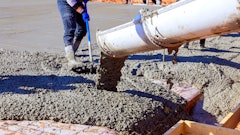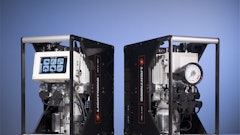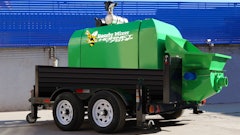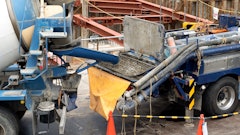
The Challenge:
Use a barge-mounted concrete placing system to place concrete 390 feet underwater over a 12-day time frame
The Players:
Southern Nevada Water Authority
Vegas Tunnel Constructors LLC
Ralph’s Concrete Pumping
The Process:
A continuous 12-day concrete pour tested the stamina and performance of a barge-mounted Putzmeister concrete placing system to place 12,000 cubic yards of concrete 390 feet below the water’s surface - an extremely long-distance feat for pumping concrete underwater. The pour secured the opening of a raw water intake structure for the Third Straw project on Lake Mead in Las Vegas- one of the largest U.S. municipal water projects.
Currently, the city of Las Vegas draws about 90 percent of its drinking water through two horizontal intake pipelines or straws in the Lake Mead reservoir, tapping the Colorado River behind the Hoover Dam. However, the depth of the drought-stricken lake has fallen more than 100 feet in the past decade. To avoid a potential crisis, a third straw is being built deeper in the lake. Its objective is to protect the community from a water shortage in case the lake drops to a level that shuts down the existing two straws.
Estimated at over $800 million, the officially named Intake No. 3 project is the most complicated and expensive construction job undertaken by Southern Nevada Water Authority (SNWA). In 2008, SNWA awarded the design-build contract to Vegas Tunnel Constructors LLC - a joint venture of S.A. Healy Co., Lombard, Ill., and Impreglio S.p.A., Sesto San Giovanni, Italy.
The project requires multiple construction facets, with a major concrete placement task that took center stage in March 2012. by Ralph’s Concrete Pumping (Ralph’s) of Seattle supplied a Putzmeister concrete placing system that utilized two Series I detachable placing booms - 118 and 125 feet - two placing boom towers, two trailer-mounted concrete pumps - a BSA 14000 HP-D and a BSA 2109 H-D - and Putzmeister's concrete delivery line with ZX ends. This particular delivery line system alleviated concerns about concrete spillage in the water as the line and couplings are leak-proof and rated for extremely high pressures.
A complex process
A raw water intake structure, basically a concrete-and-steel funnel 100 feet tall and weighing 1,200 tons was floated almost three miles from shore and methodically sunk to the bottom of the lake, making its home in a huge 60-foot-deep pit that was previously blasted with explosives. A single, continuous 12,000-cubic-yard concrete pour would fill in the hole and keep the structure in place.
The multifaceted concrete placing process started on shore with an on-site batch plant set up to continuously supply a specially-designed concrete mix. Ready mix trucks, each loaded with 10 cubic yards of concrete drove onto a transport barge, eight at a time, to be ferried across the water to the equipment barge three miles offshore. To maintain a non-stop flow for more than 250 hours, three transport barges kept 32 ready mix trucks cycled between the shore and barge.
Due to the critical nature of the pour, two complete concrete equipment setups were installed on the barge - one system would be operational while the second was on standby for maintenance and backup.
Once the ready mix trucks reached the equipment barge, concrete was discharged onto a 40-foot Maxon conveyor that transferred the concrete to a second Maxon conveyor needed to elevate the concrete into a Maxon Maxcrete remix surge hopper. The Maxcrete, with bi-rotational agitator shaft, allowed retempering the concrete as needed from the 1,200 plus loads of concrete. The 10-cubic yard Maxcrete also provided surge capacity during the transition when the first transport barge would pull away and the next would arrive. This would provide a continuous concrete flow to the BSA 14000 trailer-mounted pump, paired with the 125-foot placing boom as the primary operational system.
In turn, the high pressure trailer pump pumped the mix through 20 feet of Putzmeister delivery line to the placing boom mounted on a 20-foot-tall freestanding tower. No counterweight was required for the Putzmeister placing boom, so it offered a lighter weight on the equipment barge floating atop the water. The placing boom, capable of extending 108 feet, 7 inches horizontally, maneuvered its four-section boom into a 10-foot-diameter tremie pipe that delivered the concrete 390 feet to the lake’s bottom.
“The placing boom was powered by a 3-cylinder diesel power pack instead of the more commonly used electric power pack, which would have required a great deal of power from a generator,” says Gribble.
No divers were in the water guiding the work. Instead, the crew at the surface used sonar, GPS sensors and a single remote-controlled submarine to monitor what was happening below the water’s surface.
“At times, concrete output peaked over 100 cubic yards an hour, which is a high volume for this type of application, especially with the distance and steps involved to consistently move the concrete from the shore to the bottom of the lake,” adds Gribble.
The pour was proceeding as planned until the sixth day when strong winds gusted up to 60 miles per hour on the lake, sending waves crashing over the platform and causing treacherous conditions for the barges ferrying ready mix trucks. The job shut down for nine hours.
Since the concrete mix had a 30-hour set time the strong winds didn't affect the quality of the finished product. The set time was initially specified to provide ample time to inch the concrete around the intake structure and add new layers before hardening; however, the 30-hour set time also accommodated the unexpected wrath of nature.
Eventually, the intake structure will connect to a 20-foot-diameter, 15,000-foot-long concrete panel reinforced tunnel under the lake bed. This will occur when a tunnel-boring machine on a 1,571-day mission reaches the intake structure, after digging three miles through solid rock beneath Lake Mead. The entire raw water intake project is presently slated for completion in early 2014.



















